Should You Prewash Fabric Before Quilting?
A wise woman once said to me, “Suzy, the very first thing you should do when you get home from a fabric shop is throw all of your fabric into the washing machine. One must prewash fabric before quilting. It's essential.”
Another wise woman also said to me, “Prewashing?? I ain't got time for that.”
Thus began my inner debate – to prewash or not to prewash fabric before quilting?
Those Who Prewash Fabric Before Quilting Have Their Reasons
It Prevents Bleeding.
Prewashing does more than just fluff up your fabric. One of the most important things washing your fabric can prevent is the dreaded bleed. For those who have never experienced a bleeding quilt, thank the sewing gods for your good fortune. However, all of those who HAVE watched in horror as navy dye seeps into a once cream fabric, raise your hand. You, my friends, don’t need me to tell you that pre-washing fabric can prevent vibrant dyes from spreading onto other fabric. Reds, purples, and dark blues are the usual suspects. In my case, it was a fabulous navy with beautiful metallic gold dots.
I hate that fabric now. It is my enemy.
Trending patterns!
To help prevent this bloody tragedy (Can I say that? If it was once bleeding, that makes it bloody, right?), add a couple tablespoons of Retayne* to the wash. Here's a quick refresher on the two main chemicals we talk about dumping into our washing machines here at SQ:
- Retayne: sets dye into fabric. Retayne PREVENTS fabric dye bleeding by locking dye into fabric. DO NOT use it if you are experiencing a fabric bleed situation. I keep a bottle of Retayne in my laundry room and pour some into every prewash that includes highly saturated color fabric.
- Synthrapol: releases dye from fabric. Knowing that, I don't think I need to warn you not to dump this into your washing machine when washing a quilt....cause you know that, right? Use Synthrapol when either dyeing your own fabric or working to get naughty fabric from bleeding. Read more about fixing fabric bleeds here.

Get tips on sewing with different substrates!
It Removes Chemicals.
Sensitive skin anyone? If you have a propensity for itchy, irritated skin, you may want to consider jumping into the prewash camp. By washing your freshly purchased fabric before sewing with it, you are removing any sizing (more on this later) or chemicals acquired during its life in a factory.
Shrinkage.
This word is going to make an appearance in both the “Pros” and the “Cons” list. Basically, fabric shrinks once it’s been washed and dried. Yes, yes, I know you already know that. What you may not have thought about is how this radically changes the look of your quilt if the majority of the shrinkage happens after it’s been quilted. By choosing to prewash fabric before quilting, you are decreasing the crinkle effect (similar to the butterfly effect in that this one decision can be world changing….think about it.)
So ask yourself, “Do I want my quilt to shrink up and look instantly vintage and crinkled after it’s laundered?” Or “Do I want it to look relatively the same as when I first sewed it together?”
Below is a quilt made with fabric that was not pre-washed. Keep scrolling for pics of it after it's been laundered.


The quilt featured in this post is the Triangle Jitters quilt pattern. Download it here!
Prewashing? Notgonnahappen.
It Takes Too Much Time.
Also sometimes you forget! Also sometimes you are running home from the fabric shop because it is imperative that you begin cutting into that fabric you just purchased immediately. Like world-endingly imperative that not a second is lost!
What I’m saying is, sometimes life gets busy and you just want to quilt. For those of us who are not great at planning ahead (raising my hand), prewashing feels like the step we forget to take until it’s too late. Because once that rotary cutter is in hand, no prewashing will occur.
Remember Those Chemicals?
We actually like some of them. As mentioned previously, sizing finds its way onto fabric fresh from the factory. Sizing is similar to starch in that it adds crispness to the fabric and reduces wrinkles. This added stiffness makes it easier to cut and sew.
Shrinkage.
Oh, hello again. Fancy seeing you here.
Where my crinkle-peeps at?? If you love the look of a fluffy, puffy, puckery, cozy, cuddly quilt, then prewashing fabric before quilting is not for you. Fabric is going to shrink after that first wash, so if it’s now part of a quilt, it will slightly pull at that stitching – giving your quilt maximum crinkleage. And that’s a word. Just don’t look it up.
A Few Final Prewashing Tips
Whether or not you prewash fabric before quilting, at some point you will need to wash your finished quilt. Check out this post on washing, drying, and caring for your quilts so they last and stay nice as long as possible.
Don’t Prewash Pre-cuts.
By “pre-cut” I mean anything the size of a Fat Quarter*fat or smaller. Those little cuties are small enough that their raw edges may unravel a lot. So much unraveling can occur that it no longer fits the requirements for a Fat Quarter quilt pattern.
*Fat Quarters are quarter-yard cuts of fabric cut wide (hence the name fat). Rather than a classic long and narrow quarter, which would be 9" x 42", an FQ is approximately 18" x 21". If you are looking for a cute FQ-friendly quilt pattern, check out this post about all of the pre-cut patterns we offer — The Best Pre-Cut Friendly Suzy Quilts Patterns.
Color Catchers Can Save Your Life.
Whether or not you pre-wash or don’t pre-wash, it’s not a bad idea to throw a Color Catching sheet into the wash with your quilt – especially if your quilt includes saturated colors. A nervous giggle always escapes my mouth when I see how much dye those catchers collect. You can find these in the laundry detergent aisle.
Now go forth and prewash! Or don’t. It’s totally up to you. As you can see, Scrappy is impartial.
Want one more before and after shrinkage example? Let's look at my Gather quilt. I did not pre-wash this fabric. Here's a photo if it finished, but before washing the whole quilt...
And here's a photo showing off all of that cozy crinkliness. Desi and Scrappy are enjoying it's warmth from the dryer.
Here it is again, folks. Close up before washing...
And close up after washing. The quilt, that is. The toddler looks a little dirty 😉

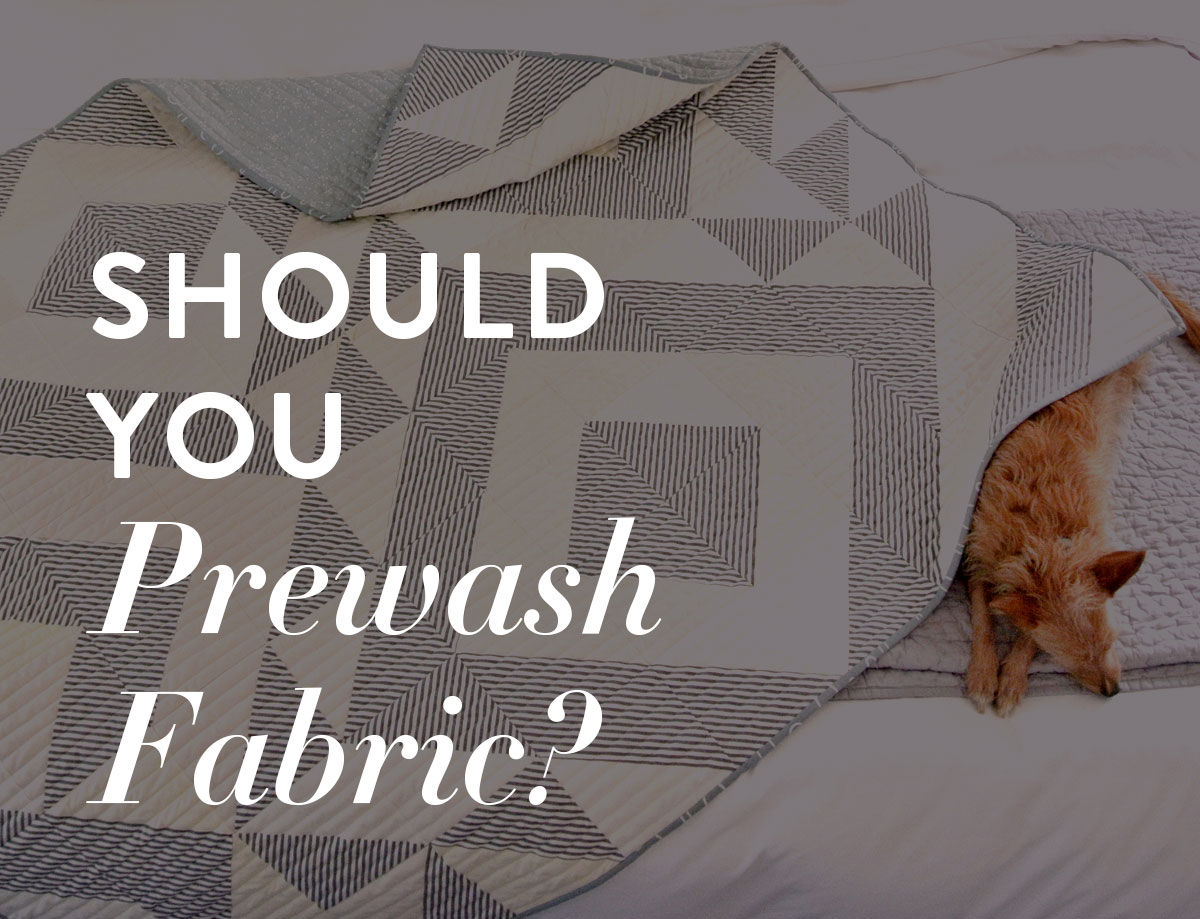
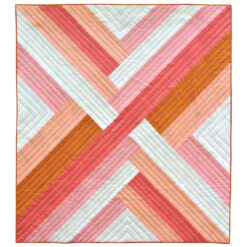
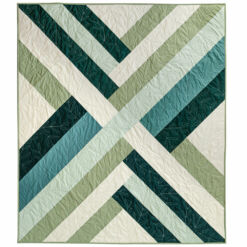
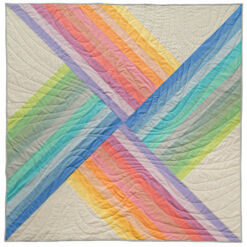
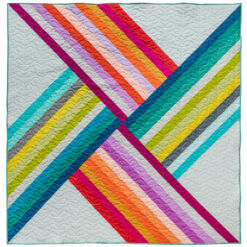
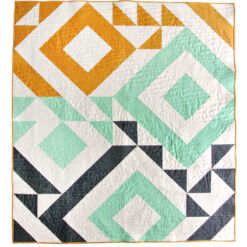
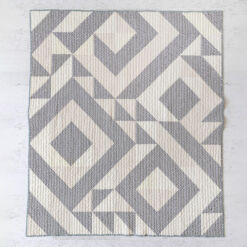
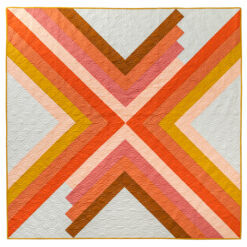
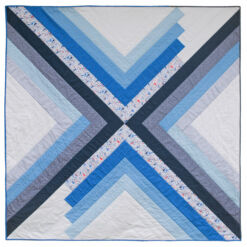
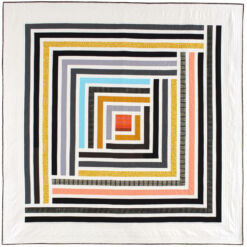
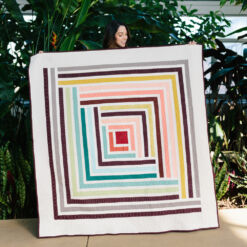
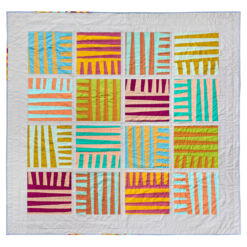
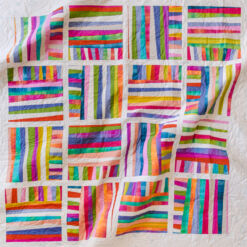
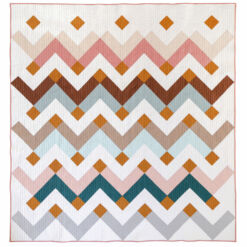
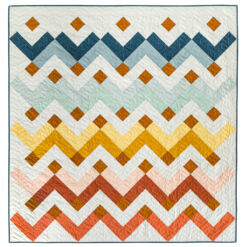
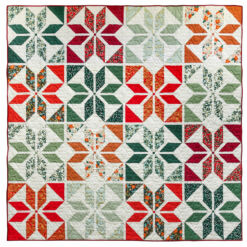
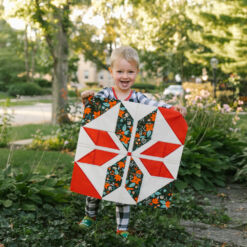
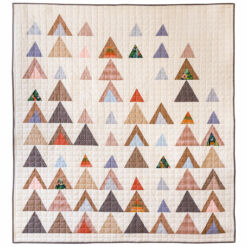
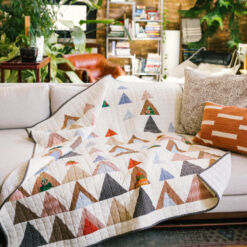
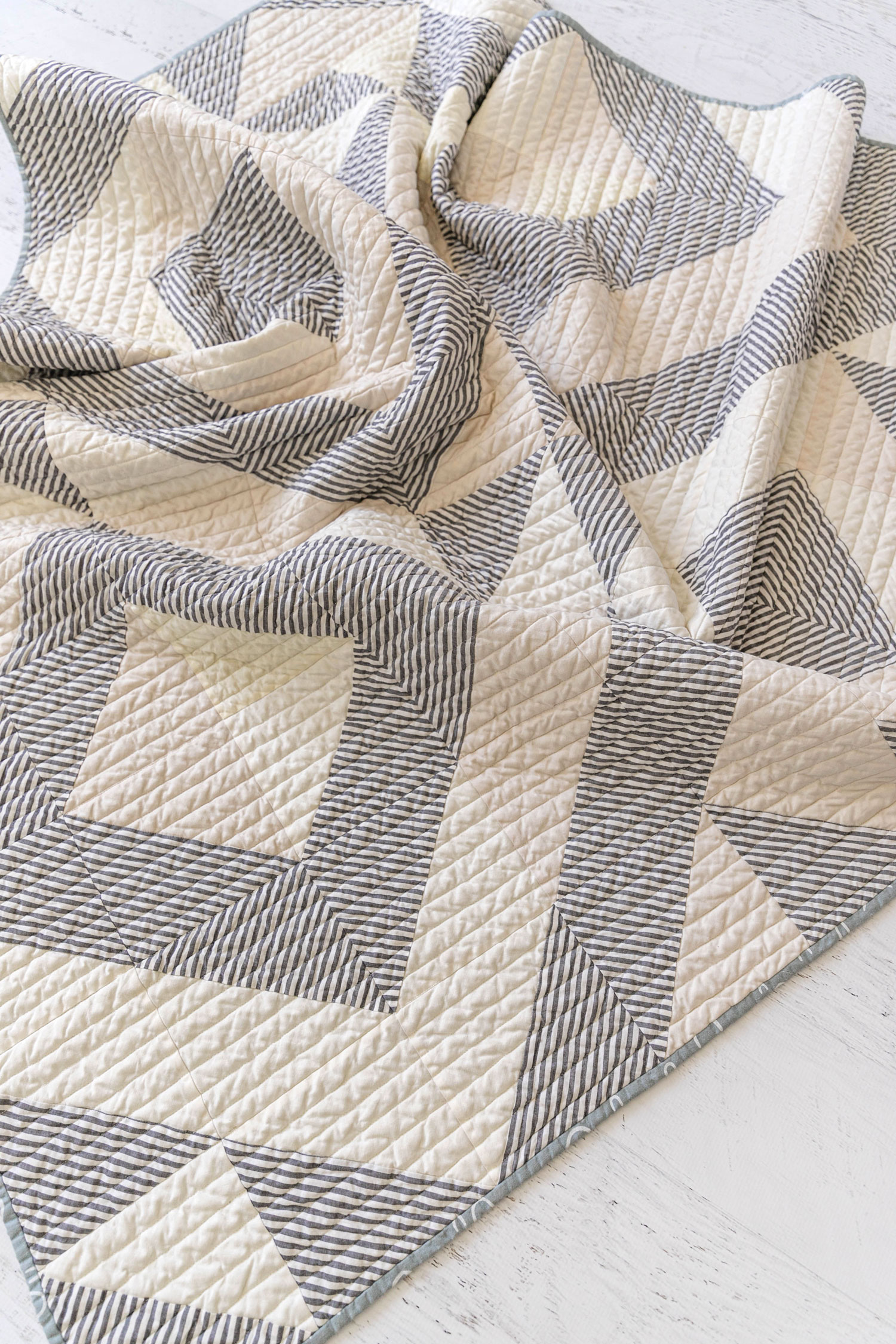
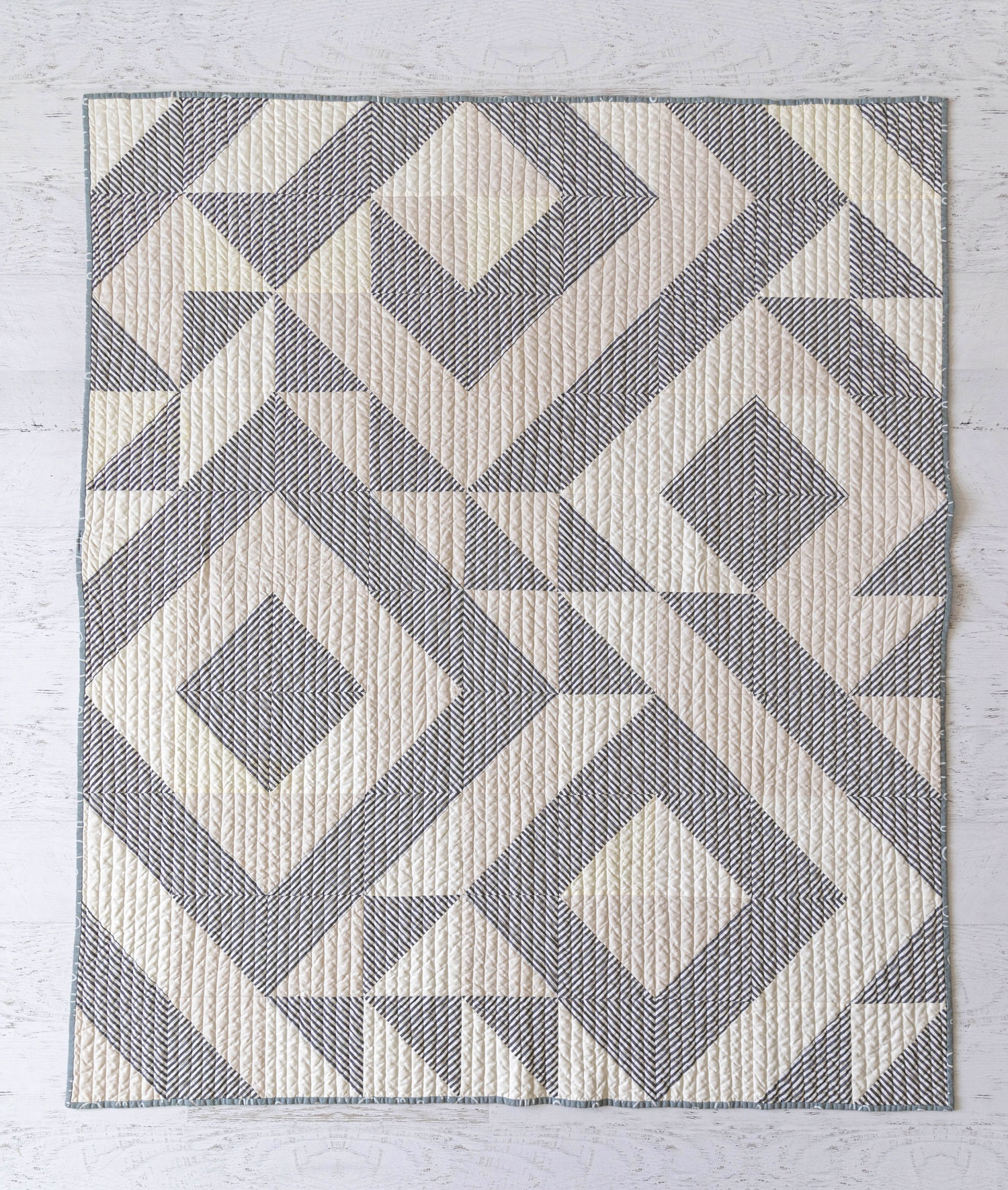
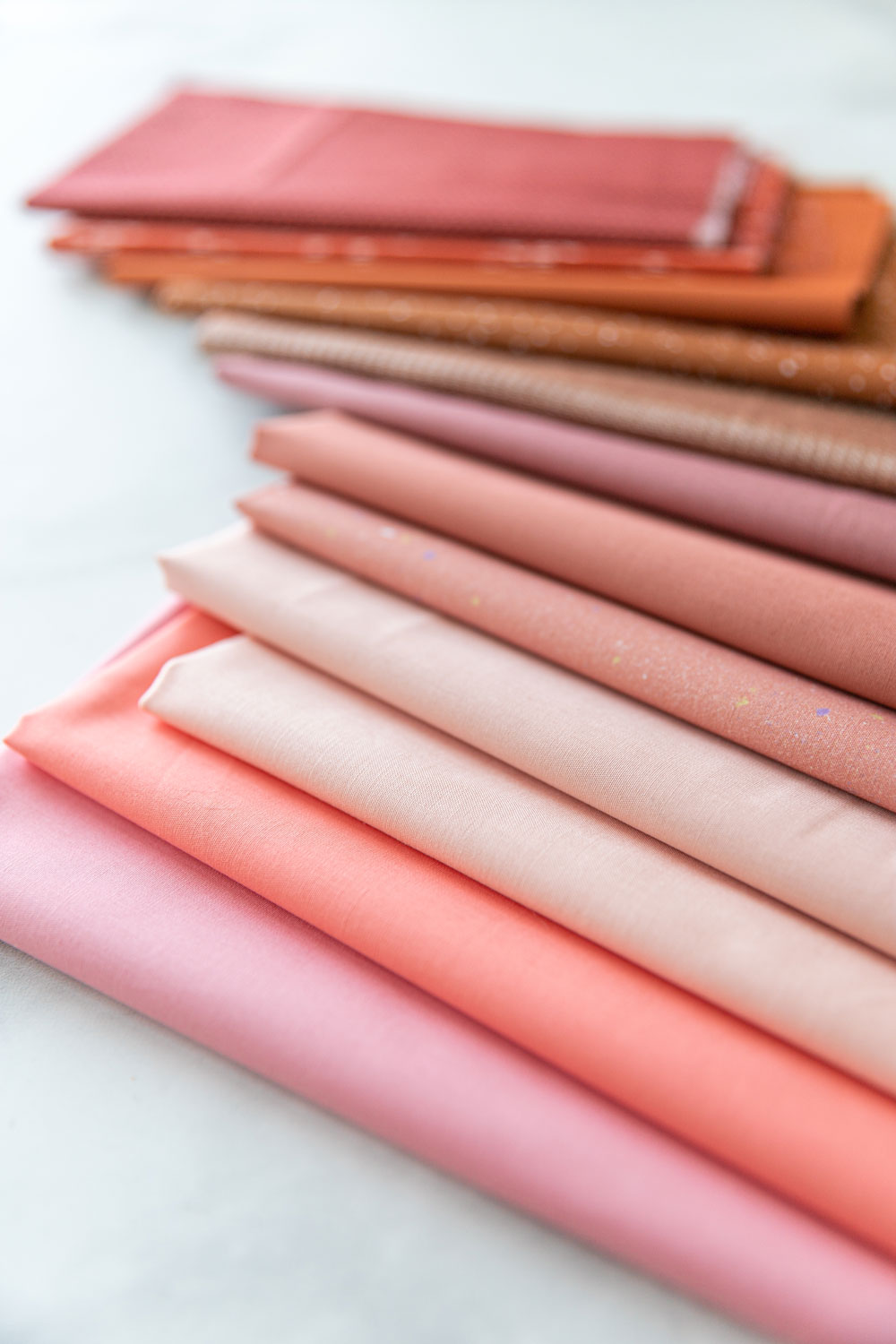
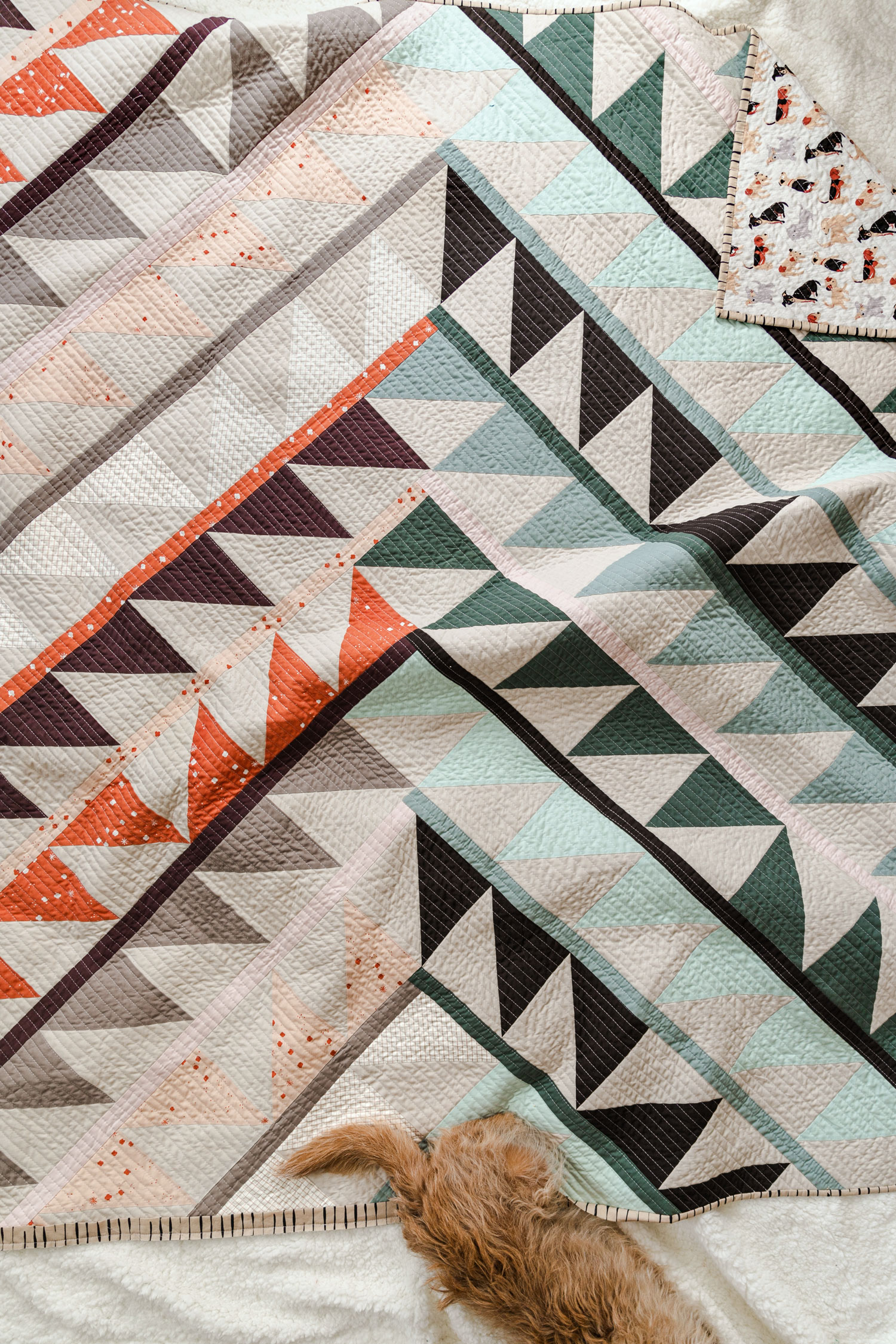
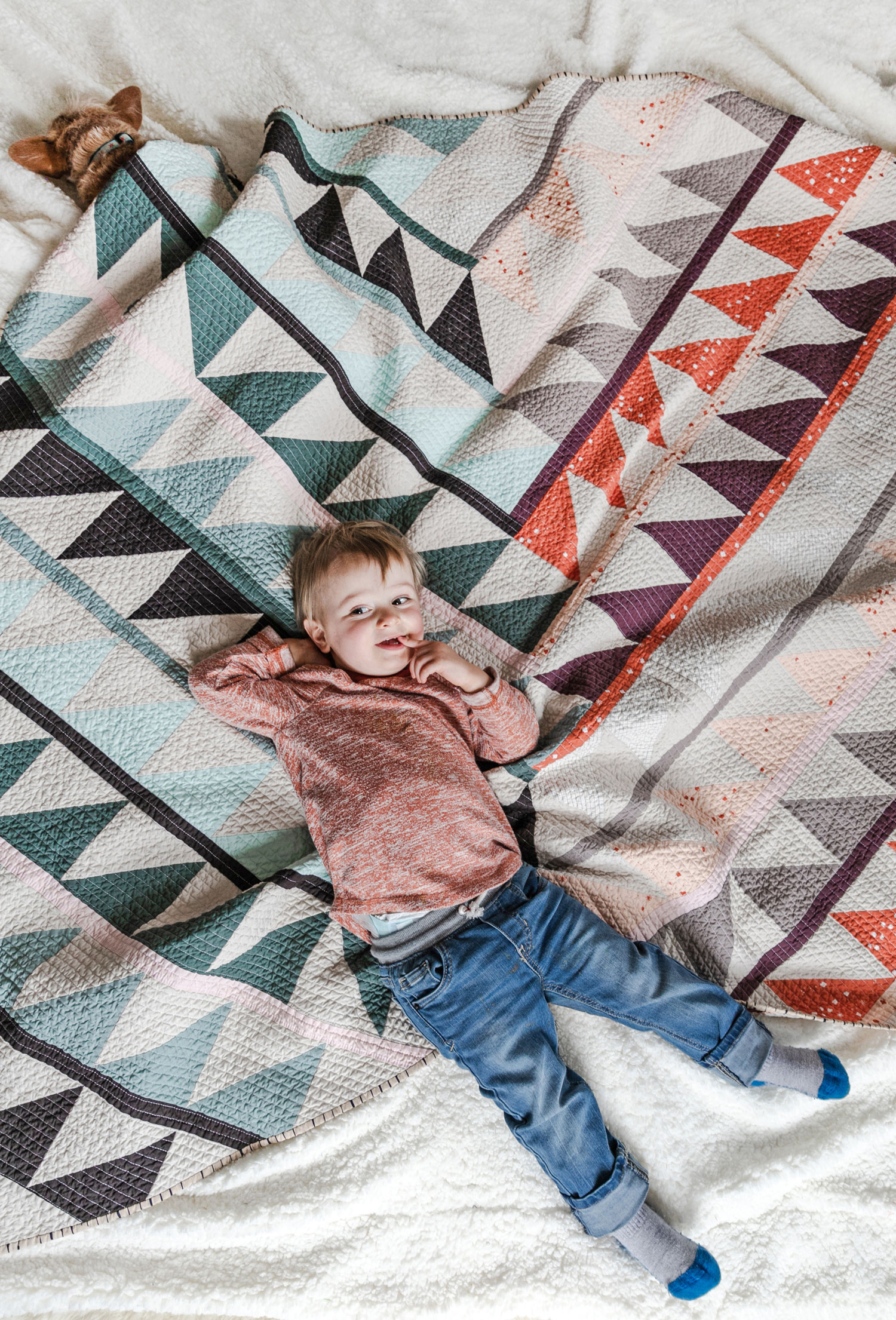
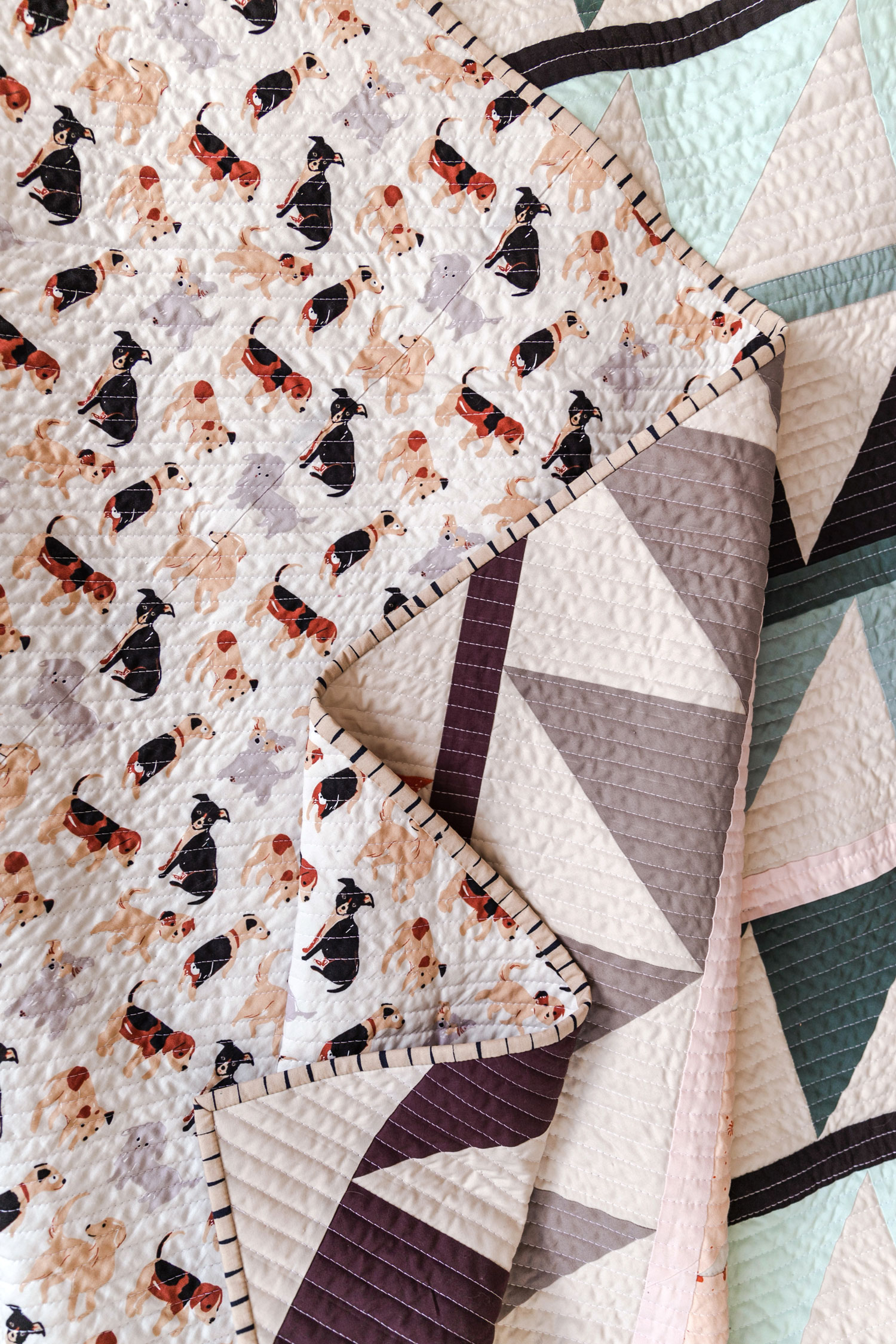
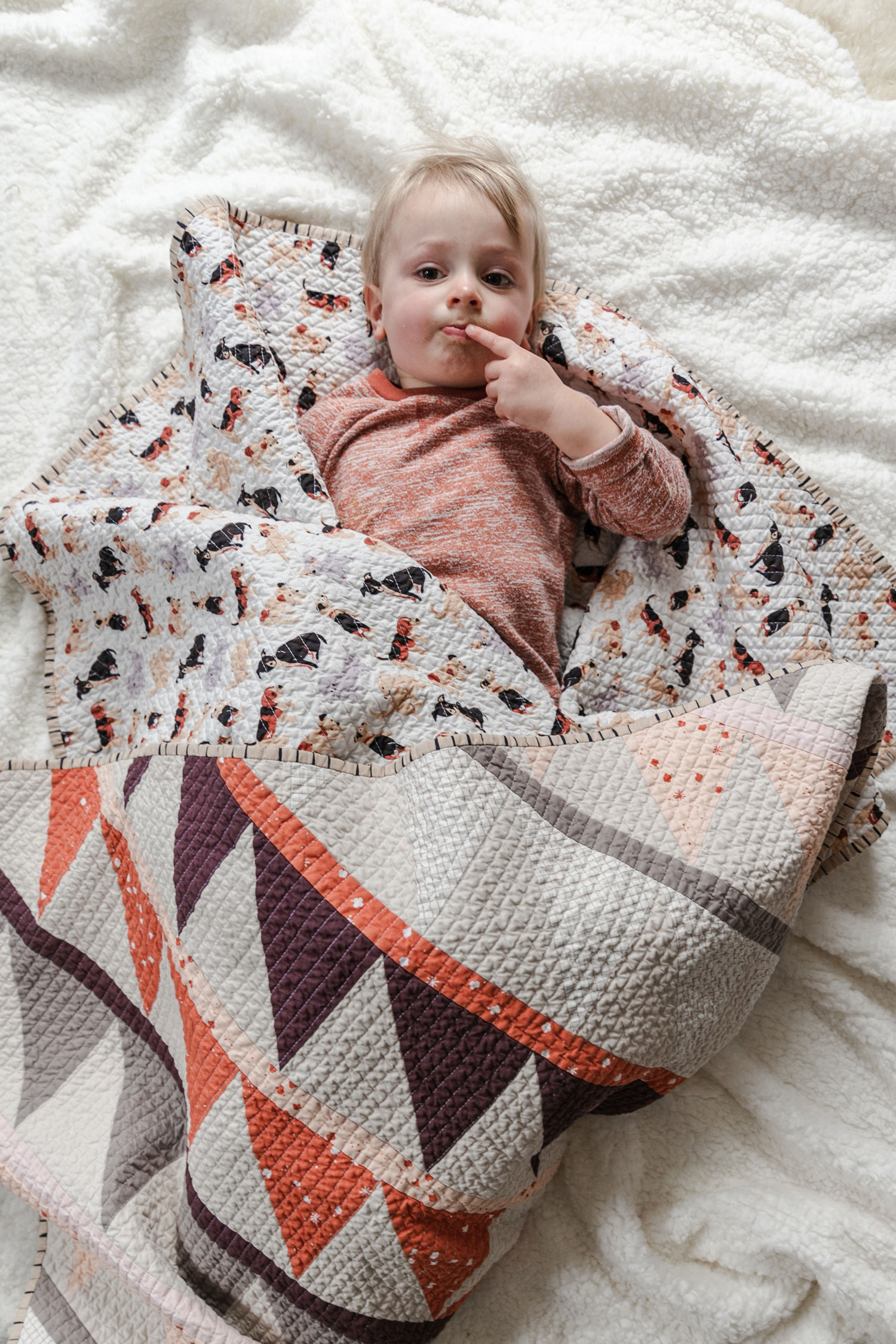

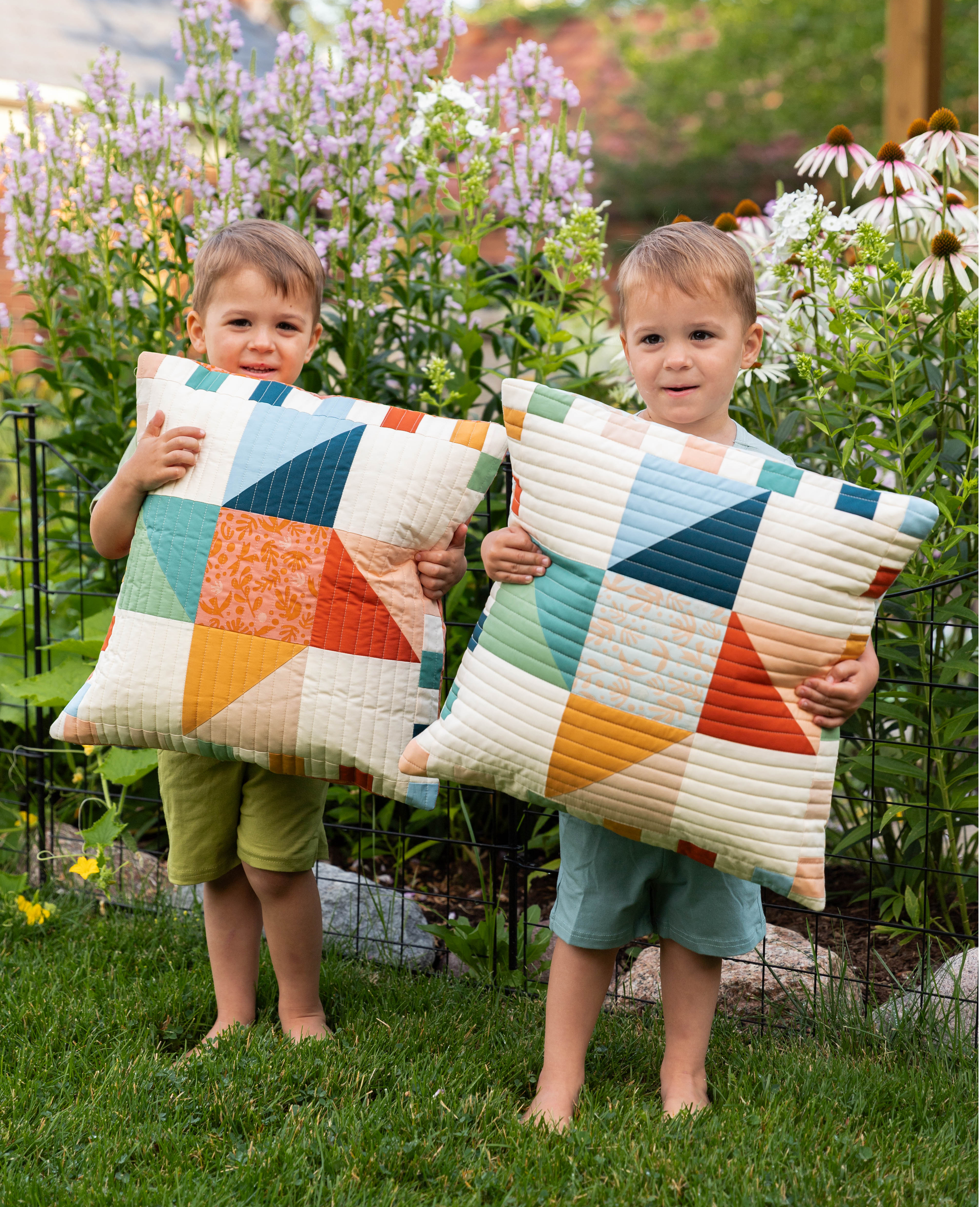

I love getting to see this Jitters quilt in your posts. Thanks for sharing! I’ve been shopping for fabric to make a quilt with your Reverse Sawtooth tutorial. I sew clothes and toys for my son, but I’ve never made a quilt before. I’ll plan to send you a photo or two if it turns out!
That’s a great quilt to make and a lot of fun picking out the fat quarters! Good luck!
Once I started using precuts I stopped prewashing so all my fabric would be the same when the quilt was washed. I always wash a quilt with colour catcher before I gift it.
Me too! I ALWAYS wash a quilt with color catchers before gifting!!
Same
I’m relatively new to quilting, less than a yr! However, I’ve come to love it, at least the easy ones! I have been busy ordering fabrics and making throw quilts constantly! I have made 14 quilts, and one in the works! I have been using my family as guinea pigs, so I can practice! Everyone has dearly LOVED them! I hope to sell some since I love quilting so much!! I pre-washed two times… I was done with that! I refuse to prewash now, I am a color catcher queen! Lol The main reason is, the crinkle effect, I LOVE IT! It was interesting and informative to read your article on this subject! … but I will remain in the NO PREWASH camp! Lol Happy quilting! ☺️❤️
Haha! I like to hop between camps, but am mostly with you 😉
I’m brand new at this (just a few months) but am obsessed and must have fabric for my next project before I finish one…(I’m trying to tame that). Anyway, one note about prewashing: I read that if you are using a flannel backing that it should be prewashed as it shrinks different than the regular cotton, so I am NOT prewashing my quilt fronts and I AM prewashing my flannel backs and have been happy so far, although I have not used a lot of very dark or bright colors yet. Thanks for your tips…Side note: I use your binding video every time I finish a quilt (starting with baby quilts here) and cannot live without it…works perfect every time! Thanks for your continued help!
If you use a 100% cotton batting, do you prewash that?
Usually batting comes prewashed, so you shouldn’t have to.
I prewash, I guess because I came from sewing clothes to quilting. I serge edges and wash as small as
a FQ. though I can generally tell the difference, I also mark on the selvedge if washed.
I wash every quilt when done and always use color catchers.
Prewasher over here! After a handsewed and handquilted black/white/red quilt came out of my washingmachine PINK😱😱 although I put a gazillion colourcatchers in the machine..(and I really hate pink, haven t got a single piece of pink fabric in my stash!) I was horrified!
I made another red/white quilt ( again by hand), prewashed all the fabrics and……I never washed it out of fear of another disaster. Better a bit dusty and a little dirty than PINK!!
I’m in the never prewash camp. For two reasons, first I prefer to cut and sew non washed fabric and secondly I like the crinkly look of quilts.
Thank you for showing us the quilt comparison. I’m normally of the “no prewash” camp unless I my quilt sandwich layers have considerably different shrinkage factors.
Love the post! Thanks!
Where could I find the patern of this quilt in tne pictures?
Thank you! It’s called Triangle Jitters and can be found here https://suzyquilts.com/shop/triangle-jitters-quilt-pattern-download/
What if you didn’t prewash the fabric. You completed the quilt top. Then gently washed the quilt top by gently swishing around in a bathtub. Suppose you would have to press it…….don’t know. Then have it quilted. How would that work? Would I end up with one fine mess?
Oh no you’ll be just fine. I didn’t prewash any of the fabric used in the Triangle Jitters quilt shown in the pictures, and the only thing that happened is it crinkled up and looks more antique. If you are using dark colored fabric, though, I highly recommend using a couple color catcher sheets when washing the quilt for the first time.
I am in the ALWAYS pre-wash camp mainly because I started out pre-washing and now I can’t stop. Also I am sensitive to the chemicals on new fabric. Itchy hands are no fun. I keep thinking someone is going to give me money. (My grandma told me that one. ) So sad when it never works!
I think that’s the safest way to quilt. I’ve worked with a couple fabrics that have smelled pretty weird and made my hands itch.
I have started pre-washing for ONE reason. 3 days before my niece got married, I finished her quilt-butter yellow with black. A curved log cabin. Yeah, red center blocks. Yellow faded, black & red faded-into the yellow. Oh, and did I mention streaks fo black & red into the now faded yellow?! No gift went with me. The next quilt I made. The happy couple was prewashed (and finished in record time!).
Sometimes I forget to prewash (gotta start that quilt), but I cringe when I start.
Sheri, that is heartbreaking! I hate hearing that. I had a quilt bleed on me once and it turned into a 24 fiasco with lots of soapy water and pleading with God. Have you tried working out the bleed from the original log cabin quilt? It might be salvageable. This article may help – https://suzyquilts.com/fix-fabric-bleeds/
Thanks so much for the article and all the comments. I haven’t decided which camp I’m in I have done both with no horror stories. I just have 14 quilts to make this year,(I am leaning toward not washing
I wash everything before using or even wearing.
1. Because the first load I did on my own in college turned all blue and tough lessons linger longest. (Darn those tie-dyed MC Hammer pants!)
2. I’m allergic to everything and need to wash fabrics in my super-duper fragrance-free environmentally friendly stuff.
3. I tend to use really dark colors and have been known to repurpose fabric from other sources.
4. I can’t remember…there was another.
Strangely, as far as my regular wash loads, as long as something has been washed before, they all go together. I don’t separate whites from colors or anything. Doing one load is more important to me and the environment than getting all sorty-sorty. 🙂
I prewash all fabric with any cotton in it. A long time ago, before my prewashing days, I sewed a bag for myself with fabric straight off the bolt. I used that bag often till it needed to be washed. It shrunk. A shriveled-at-the-seams, wrinkly purse isn’t as sweet as a crinkly quilt and ironing didn’t help. So now I prewash. Plus, I never have to postpone a project because the fabric has to be laundered first, like for clothes or bags. On the other hand, I did wash a Fat Quarter bundle once and regretted it. As you said, it was for a quilt designed to be cut from FQs, and many pieces shrunk too much. I had to get creative with that one. Thanks for the post! A good read, to be sure!
Great point about prewashing before making a bag. That would be so disappointing to have all of that work shriveled up!
Look carefully at seersucker. I wash it before using.
I am new to quilting and am excited to make your weekend candy quilt as a baby gift for my sister. Should I prewash the 1/4 yard fabrics before starting? I thought I could at least wash the larger backing fabric. Thanks!
Greet question! If you prewash a cut that small, I recommend trimming around the edges with pinking shears so you don’t lose precious fabric to fraying.
I am a Pre Washer, however I have learned that if I wash my fabric in cold water on the delicate cycle with just a splash of baby laundry detergent (optional) there is very little fraying. Also I do wash my darks separate from my lights so this helps to stop the bleeding of colors.
I do something similar. Sort lights from darks, and among the darks, reds/oranges from blues/greens. I use a *minimal* amount of mild laundry soap, cold or warm water depending on how I feel that day, and a short wash cycle. On my washer there is a “rapid” cycle. Next I dry to completion in the dryer, followed by a quick press using my steam iron.
I prewash because I like high contrast and tend to include highly saturated colors in my quilts. I had a finished quilt ruined by colors bleeding. You only need to have that happen once to turn you into a prewasher! Even though I did prewash, I had another awful experience with a set of beautiful hand dyed fat quarters. I was able to reduce the bleeding, using color catchers in a subsequent washing.
I’m wondering about a set of linen fat quarters that I have… Elsewhere on your blog you recommend prewashing linen because of the shrinkage, but here you suggest that prewashing fat quarters can result in too much shrinkage for patterns (which I’m worried will be the case with my fabric!). What would you do in this case? Thank you!
Great question! In this situation, I’d say it’s up to you. Linen will shrink up a lot so if you don’t prewash, it will get veeery crinkled as a quilt. If you do prewash, sew a basting stitch (that’s a long straight stitch) around the edges of each fat quarter so you don’t lose inches due to fraying in the wash.
i don’t pre wash and actually found a quilt pattern where they don’t want you to pre wash as the sizing is important for the cutting. The quilt is a One Block Wonder.
I pre-wash fat quarters too, but nothing smaller. I pretty much really only soak them in hot water; not a lot of agitation. Also, if you make tiny little 1/8″ snips along the cut edges they don’t ravel (but it’s a real pain). I have used pre-cuts and am always terrified that all colors will break loose when it’s washed for the first time. I just gave a quilt as a wedding gift with white background and all sorts of blues in HSTs; I included a zip baggie full of color catchers, but I’m still concerned about what will happen when they wash it.
Does Retayne work forever? I mean, if you add it when you pre-wash, is the dye permanently locked, or does it need to be repeated after a while?
It’s my understanding that Retayne is permanent, however, most dyes will fade with repeated washing.
First off, 3 of my 4 quilts I have made were your patterns, so thanks for that =).
Next, I have a question for you: I have prewashed all my fabric, assuming that it would eliminate the crinkly look, but nope, it didn’t (I’ve only washed one of the quilts, so I can’t say what the others will do). Perhaps I needed to pre-shrink the batting? I don’t love the look, so I was a bit disappointed =/.
Oh bummer! I’m sorry about that. Let’s run through the list – you prewashed your backing and your top fabric. Check. If you purchased batting from a major batting company, it was most likely preshrunk, but you might want to go ahead and check anyway. Did you use cotton thread? Sometimes even your thread can shrink, so if you hate the crinkled look, switch to poly thread. If you checked all those boxed, the last thing you may want to do is prewash all of your fabric in hot water so that it shrinks to the max pre piecing.
Hi. Ididnt prewash my layer cakes. The quilt top, is done should I now wash top and bottom, before it goes to the quilter?
No, I would suggest waiting to wash your quilt until it’s completely finished and bound.
The vinegar works for sure. I have done that.
What is your feeling on mixing prewashed and unwashed fabrics in one quilt? I was always a prewasher (because that is what they always told you to do about 15 years ago) but now have started not prewashing with some of my newer fabrics and of course, precuts. Can I mix prewashed and unwashed fabrics in one quilt? When I wash the finished quilt for the first time, will it make the quilt wonky. Thinking of trying to experiment on a scrappy quilty to see what happens.
Great question! I don’t think it will make your quilt look noticeably wonky. What you may notice is that the fabrics that were not prewashed crinkle more underneath the quilting than the prewashed fabric. This will be subtle, and maybe only you will notice. You could do some mixing in a mini quilt and see how that looks after washing.
Pre-wash camp here. In addition to all the good reasons discussed here, I have allergy problems if I use a steam whilst ironing un-pre-washed fabric. The sizing and finishing chemicals dissolve into the steam and waft right up my nose. A headache is sure to ensue. Yuck!
I have a flannel jelly roll that I am debating on whether to pre-wash or not. I have never worked with flannel before, so I am concerned about washing such small pieces. Everything I see says wash flannels, but not pre-cuts. I could wash in a lingerie bag if that would work. Any thoughts?
As much as flannel does shrink, and 90% of the time you should prewash, a flannel jelly roll definitely falls into the 10% of times you “don’t prewash.” I think even on delicate you will end up with a frayed-out mess. Better to sew with it as is and accept that it will crinkle and pucker a bit once the quilt is finished and washed. But quilt crinkles ain’t a bad thing!
These are all great comments and I really enjoyed reading the ‘pros’ and ‘cons’. I have a bit of a different situation. I live in South America and all those convenient products that you mention are not available here (color catchers, Synthrapol). Does anyone have any suggestions about either pre-washing or post-washing fabrics to retain the colors? Thanks!
If you have some dark fabric that looks like it might bleed, I bet you could prewash with Dawn detergent OR just prewash with regular detergent twice. The first time in the wash throw a piece of white muslin in with the fabric. If the muslin comes out a different color, you know you’ll need to prewash again.
I’ve heard a lot of people say that washing with vinegar and salt will do the same thing. It’s supposed to lock in color.
That’s definitely worth a shot!
I have some hand-dyed, dark blue fabric that I am putting into a wall hanging. Probably never going to get washed. I’m thinking of not pre-washing any of the fabric going into that quilt. I always prewash, but this feels like a rabbit hole, because when I pre-wash really saturated batiks or hand dyes, it is an event. Days of hot water and rinsing until water runs clear. I am so not in the mood, although the fabrics for this are fat quarters and not yardage.
If it’s a wall hanging, I wouldn’t worry about it either. You’ll probably only ever spot clean a wall hanging, so I doubt you’ll run into bleeding.
Thanks!
I was hoping someone could help me out! I’m making a quilt for my mom for Christmas (I’m pretty much a beginner). I made the top out of cotton precut squares and didn’t prewash because they’re precut. The colors are white, dark purple, and coral. I’m planning on washing on cold with color catching sheets. Is that what you recommend?
I want to do a Minky fabric back. Do you recommend Washing the top (once it’s all sewn together) and then sewing together with the batting and Minky? Or do I quilt all the layers together and then wash? I’m not opposed to the crinkly look to the quilt, and I know my mom likes it too. I’m just worried about shrinkage of the cotton+Minky. Help!!
1. You’re exactly right on. If you want to be extra EXTRA cautious, get some Retayne and put that in the water too.
2. Don’t wash the top before it’s been quilted. You will end up with a mess of frayed edges and holes in your seams.
3. Quilt everything. Bind the quilt, then wash it.
Do you need to prewash organic fabric?
Although organic fabric does not use the same chemicals as nonorganic fabric, it still has some on it that you’ll probably want to wash out. Think of organic lettuce at the grocery store. Still a great option, but worth a rinse once you get home. Here’s a post on what makes organic fabric different if you’re interested – https://suzyquilts.com/organic-fabric/
If you prewash fabrics for a quilt does the batting also need to be prewashed to prevent it shrinking? I usually don’t prewash fabric, but I’m making a baby quilt and didn’t want the crinkled look so I did prewash all the fabric, but I’m not sure if I should also prewash the batting?
Most store-bought batting comes pre-washed, but it’s worth double checking the packaging. I know Quilters Dream, my batting of choice, is sold preshrunk.
I’m so torn! I’m about to make a baby quilt, and it has a lot of contrast – white with vivid pinks, yellows, and turquoise. I’m using pre-cuts that are quite small, very close to the block size, so I can’t risk losing any, and I also love the look of the crinkly quilt… but I don’t want the white to end up destroyed by color bleed! What can I do to have some idea of what to expect when I wash this prior to gifting (which I will of course do because it’s for a baby)?
If I were you, I’d skip the prewash. Once the quilt is finished use lots of Retayne in the washing machine, wash in cold water and, just for good measure, throw in at least 3 color catchers. With all of those precautions, you should be safe. Good luck!
Love the post! I’ve done small projects in the past, but I am not a serious quilter. That is, until last fall, when I started to make rag quilt throws as gifts. I’m getting ready to start on four more for Christmas gifts this year. So this is a two part question. The fabric I purchased, including the flannel I’m using as the batting and backing, are all 100% cotton. Can I skip pre-washing the fabric (I didn’t prewash last year and had no issues!) since all of the fabric I’m using is 100% cotton? Also, most of the quilt fronts are dark colors (the backs on two are a cream color) and I’ll purchase the color catcher sheets to catch dye that may bleed. But because they are dark dyes, should I go ahead and pre-wash just to be on the safe side? I personally love the “crinkly” look as it gives the quilt a more homey and snuggle feel to it. And rag quilts are meant to have just that look!
Prewashing is always option, however you do run the risk of a future bleed. If you really like the crinkle look, skip the prewash and be sure to use Retayne and/or color catchers when you finally do wash your quilt.
Please, please prewash your fabric. I even prewash all my precuts.
The extra time it takes can avoid potential heartache down the road if your
quit bleeds or shrinks unevenly. During the manufacturing process, the fabric
gets pulled out of alignment as it’s put on the bolt. When you purchase the fabric,
and get it cut, it looks straight. But have you ever noticed that, after you prewash
the fabric and line up the selvages, it’s out of alignment on the sides? That illustrates
how the fabric has been pulled out of alignment during manufacturing.
I purchased a handmade table runner a couple of years ago. After I washed it for the
first time, some of the fabric squares shrunk more than others and some of the
fabric looked like it was crooked. It’s not worth the risk to go for the “puckered” look
on your finished quilt by not pre-washing.
Good to know! Thanks, Jane!
I’m fairly new to quilting. Never used flannel before and wondering about prewashing this type of fabric. It’s 100 % cotton. Washing out the chemicals seems like a good thing as it is a baby quilt. Mostly light colors. Is flannel prone to shrinking? Should I prewash flannel?
Flannel shrinks a lot, so I recommend you prewash first. Here’s a blog post on sewing with flannel – https://suzyquilts.com/quilting-flannel-tips-trade/
Thanks, prewash it is!! The blog on sewing with flannel will help a lot when I get started!!
I always prewash. When prewashing fat quarters, I draw on my days of making much of my own clothing and do a simple zigzag stitch on the raw edges, which virtually eliminates fraying.
Is it mainly the washing or the drying that causes the shrinking? I never dry favorite clothes because I don’t like them to get worn or shrink, and I assume avoiding the dryer would mean minimal to no shrinking for quilting fabric as well? I’m asking because my son spilled smoothie all over my fabric stash and I had to wash everything. I love the idea of preventing bleeding, but I still want the crinkly look! If I line dry and iron it I am hoping I can get the best of both worlds.
Smoothie?? Oh buddy. haha! That sounds like something my son would do too. 😉 Washing shrinks fabric a little bit, but heat is the real culprit. Hot water and/or high heat in the dryer will really shrink up your stash. If you want to prevent shrinkage, wash in cold water and either tumble dry or line dry as you suggested. You can even lay some towels on the ground and dry your fabric flat on towels if you run out of space on the line. Good luck!
Question, when you prewash, do you press with steam? Or starch before cutting!
Great question! That really depends on what I plan on doing with the fabric. If it’s just pretty fabric that I will throw in my stash and save for later, I don’t do either. I pull it out of the dryer, fold it, and put it away. If I’m going to use it right away for a simple straight-seamed quilt pattern, I iron it with steam. If I’m going to use it for a quilt pattern that has bias cuts and/or curved pieces, I use starch. Here’s a post on starch that I think will help – Fabric Starch: Get it or forget it?
I have only pre washed once and I was so overwhelmed with the big piece of wrinkled fabric and trying to tackle it on the ironing board, any suggestions as how to make the ironing process a little easier?? Thanks!
Pull your fabric out of the dryer while it’s still damp, then iron it immediately. This will cut drying time and ironing time in half.
I have always prewashed as I don’t like the chemicals in new fabric. I don’t have a real opinion on the crinkly aspect so am ok either way. I did serge around some fat quarters and half yard pieces that I knew were very ravelly and dried them in a laundry bag. I still had many threads to trim off.
I can’t decide about washing some 10″layer cake squares. Black and cream will be used in the quilt. I don’t mind if it’s crinkly or not. Any ideas on this? I don’t want to lose too much of the yardage before sewing it together. Thank you!
I typically suggest not to prewash precuts. You end up losing enough of the fabric due to fraying and shrinkage that you may not have enough for your pattern.
I’ve been prewashing my cotton fabrics at 40C (100F) with washing detergent. Is this going to address the shrinkage and colour running issue? Also should I add colour catchers and Retayne for the darks and reds?
Washing and drying will cause your fabric to shrink, which is good if you want to lessen the crinkle look. Adding color catchers and retayne to dark fabric wash is a great idea. The color catchers will catch the excess dye that escapes and the Retayne will lock the dye into the fabric.
Having just completed a large hand appliqued, hand pieced and extensively hand quilted quilt with Liberty Tana Lawn on cotton fabric, I am in the horns of a dilemma as to whether to wash it first with colour catchers and Synthrapol to see how that turns out, or to use the hot water, bath tub and “Dawn” detergent method (though here in Australia I believe the alternative is “Fairy” dishwashing detergent). You see, when spritzing away the blue water soluble pencil marks from the quilting designs on pale background fabric, I discovered – to my absolute horror! – that some of the strong purple and pink fabrics ran badly. Who knows? The same could occur with the strong blues and dark green colours as well! With the high cost of Liberty Tana Lawn, I naively thought it would be colour-fast. I would be so grateful for any guidance you could provide as to which washing method I should employ, with sincere thanks in advance.
I place a colour catcher under the lable, so when person washes it will take care of excess dye.
That’s a fantastic idea!
Hello! I’m preparing to create my first quilt! AHH! I am making the Thrive quilt, with a navy blue background (and backing) and I want to do white next to it. I LOVE the crinkle look and feel, but I’m afraid it will bleed into the white too much. Is it worth the risk? Should I just put a bunch of the color catchers?
Hey Sarah, whether you pre-wash your fabric or not, your quilt will still crinkle a bit after it’s washed. The percentage of shrinkage will be smaller if you wash your fabric beforehand, but that glorious crinkle will most definitely still be there. I think you’re on the right track be pre-washing your fabric. Navy has been known to bleed and it’s not worth the risk.
Trying my first quilt, just a basic 42 pre cut squares 5×5. I have top sewn together. I want to use minky on the back. I was thinking I should wash the complete stop, since it will shrink, the minky will not (minky is prewashed). I’m very undecided on what to do 🤷♀️ .
I think your 5″ x 5″ precut squares will shrink in a weird way so that you will have to trim them once they come out of the wash. My rule of thumb is to not prewash precuts.
Hi Suzy I’m about to embark on a quilting project made of a variety of different vintage Japanese indigo dyed cotton kimono fabrics. They’re quite old and dirty. I’m partly going for a “boro” vintage look so they don’t need to be perfect but do you think they will fall apart if I wash them? I’m a bit concerned I could ruin them. Should I just do a cold hand wash in a wool detergent and let them dry outside? Any advice you could give would be much appreciated.
Since they are quite dirty, as you mentioned, I think it best for you to wash them before spending any time sewing with them. I doubt they will completely disintegrate in the wash, however if they do fray, that’s really good information to have before you pick your seam allowance. If you notice a lot of fraying, you may want to bump up your seam allowance to 3/8″ or even 1/2″. I think you’re right to hand wash them with a gentle detergent. Baby wash would even do the job, and we know that to be very gentle. Good luck!
Thank you so much for the reply. I love your blog!
Hi again Suzy, do you have any tips for working with a variety of vintage fabrics that won’t be completely uniform in their weight and texture? I don’t think I’ll be able to achieve the precision or the perfect points as some of them will be a bit uneven. That’s okay because I’m going for a slightly boho look. But are there any patterns or methods that you would recommend I consider when approaching such a project? I’m pretty new to this but trying not to be too ambitious. Sorry if I have replied to the wrong thread. Thanks again.
Interesting question! If you feel that some of the fabrics are very light, you could iron some lightweight (emphasis on the lightweight, you don’t want heavyweight interfacing because that is used for structure in bag making) interfacing to the back of some of the lighter fabrics. And if you are looking for a simple quilt pattern, check out this post – https://suzyquilts.com/the-best-beginner-quilt-patterns-for-new-quilters/
I don’t have a washer/dryer in my little NYC apartment and I’m too impatient to wait for my weekly laundromat run when I get a new fabric! Does anyone know if handwashing does anything at all to help with shrinkage? Or is it the heat of the washer/dryer that does it? Either way, I love the crinkly effect so I’m not too bothered. 🙂
Handwashing is a wonderful alternative and works great in preventing fabric bleeds once a quilt is finished. It also allows for fabric to shrink somewhat. If you are using a bathtub, you can fill it with hot or warm water to create a similar heat effect as a washer and dryer.
Hi Suzy! I’m making a quilt using Essex for the backing, fat quarters which have majority Essex and some quilting cotton, and a mix of yardage that is cotton and another which is a dark purple Essex. I’m stumped as to the best plan of attack for this pre-wash. Would it still be okay to wash and starch everything except for the pre-cuts? I read your blog post on linen but it still has me shaking in my boots that I’ll potentially have loads of fraying since it’s majority Essex 🙈
Yes, I see what you mean. The good thing about Essex is that it’s a linen cotton blend, so you don’t have the insane amounts of fraying you would get with 100% linen. If you are using a quilt pattern that needs all 18″ x 21″ of your fat quarter, your decision has already been made for you – you can’t prewash those precuts because you need all of that fabric. However, if there is some flexibility, I would sew a zig-zag or basting stitch around the edges of your precuts and then prewash everything. If you don’t end up prewashing, I really do think you’ll be fine too. Just make sure your seam allowance isn’t any smaller than 1/4″.
Silly question: after prewashing, when you get the wrinkles out are you ironing or pressing? If you’re ripping to get the fabric on grain, do you rip before or after ironing? When do you starch into relation to washing, ironing, ripping? So many options!
When you are getting wrinkles out of fabric you are technically ironing because you are moving the iron over the fabric. When pressing, you mostly just place the iron down then lift it back up without moving. If ripping fabric to get it on grain, do that after you have ironed it. If using starch, starch your fabric right before cutting it. It’s best not to starch fabric then stick it in a drawer. Here are some links that will help if you haven’t already seen them:
• Starching fabric – https://suzyquilts.com/starch-quilt-fabric/
• Pressing seams – https://suzyquilts.com/how-to-press-seams-in-a-quilt-with-video-tutorial/
• Ripping fabric – https://suzyquilts.com/grow-quilt-sew-along-week-2-cutting/
Thank you! I love your patterns and tutorials and sew alongs!
Always so helpful! I’ve learned so many valuable quilty tips and tricks from you! I’ve wondered though, if we don’t prewash, would you recommend using Retayne with your first quilt wash along with color catchers? Or could you run the risk of having a fabric bleed and locking it in at the same time? 😅
Unless you suspect a bleed will happen (ie. you’re using dark batik fabric or cheap/old red/purple/blue fabric, Retayne and color catchers is all you need to do.
Suzy, I’m doing the Maypole quilt as only my second-ever quilt, so I’m a little new at this. I do prefer the crinkly look for quilts, so I was planning not to pre-wash, based on what I’ve been reading. My fabric is all 100% quilting cotton, and I’m planning on using all-cotton batting. My color palette for this is pale orange, darker orange (specifically: https://www.stashfabrics.com/p/pure-solids-yardage?v=4369), light aqua, muted teal, and a print that incorporates those colors but only a tiny bit of orange in it. That darker orange is the only one I think could bleed because it’s the only saturated one. Do you have any experience with oranges bleeding/not bleeding? I’ve owned and washed tons of orange things (favorite color!) and never had anything bleed, but I wasn’t sure if it might be a different case with quilting cotton. Thoughts on pre-washing just the dark orange and not bothering with the rest? Thanks!
In my experience, orange is not a scary bleeding color. Maybe it’s the presence of yellow that keeps the dye so well intact? The scariest colors for me will always be dark purple, blue and red.
I’m getting towards the end of completing the top for first quilt, all 1-inch hexagons, hand-sewn using English Paper Piecing technique (hey, this lock down has to be good for *something*!). The top is made from pre-cut strips of various Batik collections, and graduates from very light colors at the top to very dark at the bottom. Since I didn’t pre-wash anything (rookie mistake) I’m now getting seriously worried about bleeding, especially with those very dark colors at the bottom. I have been making the top in sections, and I’m thinking of bathtub-soaking the top in 3 sections (light/medium/dark), and then sewing them together after washing. The trick is that I’ll have to keep the paper in place during the soaking and drying–initial tests lead me to believe this will work, but I am truly in uncharted waters, and would love advice. Specifically: put the whole thing together before soaking (with Retayne), or soak it in parts and risk it begin a bit harder to put together?
I would fully finish the quilt before soaking or washing. I would hate for your unprotected raw edges to fray and get ruined.
My Retayne bottle says: do not use in High Efficiency Top or Front Load Washers. What is your advice with that?
hmmm…that’s interesting. I wonder why. I have a top-loading washing machine that’s at least 20 years old, so I can’t speak from experience. Maybe those efficiency machines use less water so they aren’t rinsing as much? I would do some research on your specific washing machine to figure out what makes it “high efficiency.” It’s possible that just means you should use less Retayne rather than none at all.
I’m making my first ever English paper pieced quilt, using Tula Pink fabrics (vibrant colors) from fat quarters. I haven’t prewashed anything. I’m wondering at what point do I wash? Do I put the top together and then wash it before making the whole quilt (then would I have to press the seams open again- seems like a lot of work), or do I finish the whole quilt and then wash?! Thanks!
If you didn’t wash your fabric before cutting it, wait until the quilt is completely finished and bound before washing it.
Hi, I’ve just began making my first quilt..ever! I’m trying a bubble quilt (aka puff quilt). I’m using 5″ charm square, so I’m not prewashing those. Should I wash once I have all of the pockets made, before I start attaching them all together? Or wait until the quilt is completed? Thank you for any advice!! =)
I’m not familiar with that style of quilt, so I suggest only washing it once it’s completely finished.
I used to pre-wash, until I washed a layer cake (wovens! Of all things). I tried to iron them out, the edges just curled and they were all wonky. This was about 3-4 years ago before I knew what I was doing with fabric. My stack sat there just pathetically taking up space.
Then, last year I finally found a couple charm packs of the same fabric on Etsy. So, I cut all the messy, thready 10-inch squares down to 8.5 inches and made opposing square-in-a-squares to alternate with, using chambray for the outer square. The backing will be twill (just made it) and I call it “picnic quilt”.
Long story, but I stopped pre-washing all fabric about that time. The projects go together better and I don’t have to worry about “matching” pre-washed yardage with non-washed pieces.
Thanks for all the advice on your site! I also experiment with heavy thread and non-traditional backings, re-use fabrics, etc. I love to see how they all come out! My Bernina 560 can sew just about anything if I set it up right.
What about kinky fabric? I am using that for the backing. Should I prewash?
Kinky fabric? Is that seersucker or double gauze? If yes, then yes. You will want to prewash, then iron with starch.
Silly newbie questions: If you decide to pre-wash, do you just throw the fabric in the washer and use the gentle cycle? (I.e., is there any particular way you have to put the fabric in the machine and can it be washed in a normal load with other similarly colored gentles?) Also, if your backing fabric is a different weight (more or less “heft”) than your piecing fabrics–but they are all 100% cotton–do you need to pre-wash?
Hi Bree, not a silly question! Personally, I pre-wash nearly all fabrics I use, including my backs. I like to mix different weights and textures in my quilts, and it’s even more important to pre-wash when using different textures/weights to make sure that any possible shrinkage happens before piecing. Before putting my fabric in the wash, I like to do a basting stitch about 1/8″ away from the raw edges of my fabric to prevent fraying. You can also cut along the raw edges with pinking shears to prevent fraying. Then I wash my fabrics however I plan to wash my quilts (I personally do both on delicate) and throw a couple of color catchers in just in case of any dye loss. Once they’re washed, I press and starch them, then I’m ready to go! Hope that helps 🙂
Hi Suzy, thanks for this blog. I am new to quilting and I finished my first bear claw quilt during quarantine and the material was prewashed. The next one I started is a Charm Quilt and has many colors and types of fat quarter fabric . I have ordered both the color catcher sheets and Retayne. My question is can I use them together when I wash the top quilt or only the color catchers and the Retayne on fabric I pre-wash? TIA
Great question! First I’ll just say that the only time you should wash your quilt is after it’s completely finished and bound along the edges. Washing an unfinished quilt top would end up in a mess of fraying raw edges and possibly some holes in the seams. Once your quilt is finished and it’s ready for its first run through the washing machine you can use both Retayne and color catchers. Retayne will help to lock the dye into the fabric and color catchers will *hopefully* absorb any excess dye that escapes.
Can you mix woven quilt cottons with cotton batiks in a quilt? Should you use only batiks, quilt front and back? How do you wash or care for this kind of quilt? I already have a package of batik layer cakes and yardage for borders.
You definitely can mix those two fabrics. Since batiks have a reputation for bleeding in the wash, I would throw in some extra color catchers and only wash with cold water.
Thanks for accepting, and not judging, those of us who are impatient to start, and like to work with crisper fabric. I DO like a pucker, cozy quilt! If it’s for a baby, I tell Mama they may want to wash it to get chemicals out.
I pre-wash all my quilting cotton fabric before I cut it. Before going into the washing machine, I zig-zag the cut edges of the folded fabric, and I safety pin the fabric together in the middle and sometimes along the edges if it’s a very long piece. I do the same with fat quarters. After washing and drying, I rotary cut the zig-zagged edges. But I no longer purchase smaller precuts, as they will fray considerably. However, I have zig-zagged groups of layer cake 10″ squares before washing. However, after cutting off the zig-zagged edges, a 1/2″ is definitely lost. However, washing and drying also shrinks the fabric considerably.
I pre-wash ALL fabric, even pre-cuts in lingerie bags, which really reduces fraying.
Here’s why:
Modern dying techniques use formaldehyde in the process – you don’t want that on your skin.
You don’t know how it was stored in the warehouse. Was the warehouse pest sprayed and did that spray get on the fabric? Or was it not pest sprayed and there could be insect eggs in the fabric that could hatch and get on the other fabric it’s stored with?
You don’t know how it was handled. The last person to have touched it could have a contagious illness.
And I’ve found my quilts get crinkly if I use cotton batting. Not so much with polyester batting. But I’m happy with the crinkling I get.
Better safe than sorry.
Can you just prewash the red fabric for the center block in a log cabin quilt? I love the crinkly look and do not want to prewash the rest of the fabrics. I will use color catchers when done.
You definitely can! I have sewn with a mixture of unwashed and prewashed fabric. They shrink at different rates, so try to scatter them about evenly throughout the quilt.
I’ve always been a pre-washer. I never wanted to ever take a chance on my quilt bleeding after all the time and money going into a quilt. However, for the first time I’m moving over to the not pre-washing side. I just don’t have time. I have to say I might be a little uncomfortable the first time a quilt is washed this way but I’m taking the chance.
I’ve always been a prewasher, but I’ve always used yardage. This quilt I decided to get charm packs for my white fabric to save time on cutting. The other colors are plum and maroon, the dreaded dark reds and purples. What’s your opinion on prewashing the yardage and using the pre-cuts unwashed?
I wouldn’t prewash the precuts. Instead, just wash the finished quilt with lots of color catchers in very cold water.
Are Retayne and RIT Color Fixative the same thing? RIT is readily available for me, Retayne will take a few days to arrive if I order it from a large online warehouse store and I want to get started now! Curious to know if you or anyone else has ever tried the RIT.
It looks like they do the same thing by locking dye into fabric.
I have a quilt kit that uses a jelly roll and then some cotton linen yardage. I don’t know the fabric content of the jelly roll, if they will shrink the same as the yardage. I’m at a loss with what to do. Wash the yardage or not.
Since you won’t be prewashing the jelly roll, feel free to make your quilt without prewashing any of your fabric! You’ll have a lovely crinkly quilt to cuddle with after you wash the finished quilt 🙂
I usually don’t prewash fabric, but I’m making a baby quilt with a darker blue next to creams and yellows. I saw above where someone commented that Retayne is not supposed to be used in a front-load/high efficiency washer. Maybe that’s because these washers use a lot less water than top loaders. I want to prewash my fabric, but I only have a front-load machine. Do you think I should prewash the fabric in the bathtub (where I’d use a lot more water which might help rinse out the dye), or will the front-loader suffice? Thanks!
Great question! I personally have a very old top-loading machine so I haven’t experienced this issue personally. I think your bathtub solution is a fantastic one.
I just started a black and white wedding quilt for my grand daughter. Thank goodness I always prewash before and then wash after. The backing turned my color catchers pure black. I only got to light grey after the 8th wash! I have decided to now enclose a box of color catchers with every gifted quilt that I make!
How badly will homespun shrink if not preached? I have jelly roll strips so to wash that would be a MESS! Advice?
It will shrink, but I don’t think it will shrink to the point of ruining the integrity of a quilt. You should be fine 😉
Maybe you have answered this before, but where did you find the fabric as shown in the gray version of the Triangle Jitters quilt? And are the stripes 1/8″ wide? I can’t tell if the fabric is more of a gray, charcoal, or some kind of blue. Would you mind sharing?
Hi Angie! The gray striped fabric is actually an IKEA duvet! The Essex Yarn Dyed Classic Steel Woven fabric would give you a very similar look. 🙂
Help! I’m making a unicorn quilt for my granddaughter. I’m using 2 1/2” precut strips for the mane in light/medium greens and blues, white for the unicorn, a somewhat darker gray for the background and a black for the sashing and borders. Should I prewash? I know the precuts shouldn’t be washed and I wouldn’t want to deal with all those strips anyway. And how much shrinkage might there be? Might I end up with wonky unicorns if I don’t prewash? I just don’t know what to do!
Hi Dana! You’re right, we recommend not prewashing precuts. Some people never prewash anything and they’re perfectly happy with their quilts! So it’s up to you, but definitely do not prewash the jelly roll strips 🙂
Hello, I am very new to sewing and quilting. I am using your Christmas stocking post to make stockings for my daughter and son-in-law. Would you recommend pre-washing the fabric for stockings?
You can, but it’s not necessary since you most likely will not wash these stockings.
How much will my queen size quilt shrink in overall length and width if I don’t pre wash? I’m wondering how much shrinkage to allow for to get the finished size I want for my bed. Losing a couple inches will make a difference to me on the drop measurement, so I want to make sure I make my borders wide enough to allow for the loss.
If I prewash nothing when making a throw quilt I will lose anywhere from a 1/2” to an inch after washing. I think you can count on at least an inch or two of shrinkage with a queen.
I’m thinking I want to pre wash fabrics because of the chemicals in them and I have a bit of an issue with cleanliness so it makes me feel better.
However, I hate that by prewashing I’ll lose out on that lovely pucker/crinkle effect that antique quilts have!
Any tips on how to wash fabrics ahead of time but still get that crinkle end effect?
Hey Lauren! Crinkles happen in quilts precisely because of not pre-washing, so you’ll always have a smoother result when you wash a quilt that had pre-washed fabrics. I personally prefer the look of smooth quilts, so I love pre-washing! That’s a tradeoff you can experiment with over time!
I don’t prewash, but am planning to use a fat quarter of flannels from Dear Stella. Should I prewash?
I wouldn’t prewash FQs because you will lose too much of the fabric to fraying and it might not be enough for the pattern you’re making.